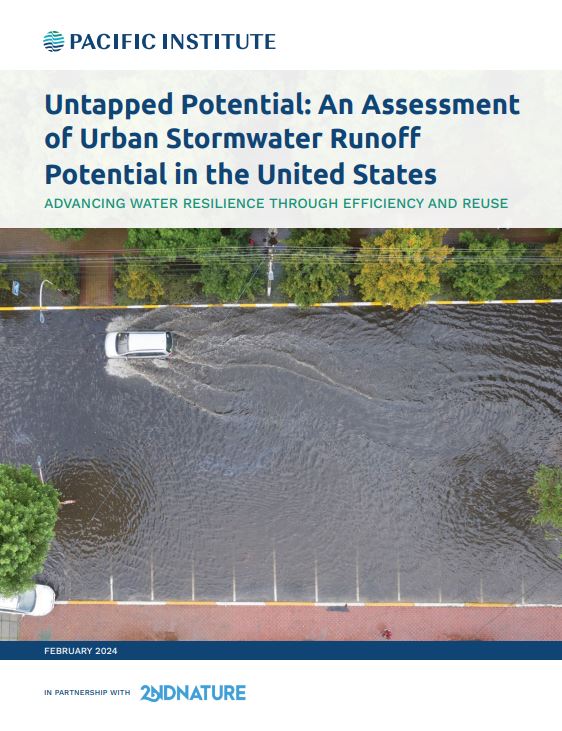Untapped Potential: An Assessment of Urban Stormwater Runoff Potential in the United States

Untapped Potential: An Assessment of Urban Stormwater Runoff Potential in the United States
Overview
Urban communities across the United States face a range of water challenges. These include intensifying impacts of flooding and drought, water scarcity risks, constraints on traditional water supplies facing peak water limits, and water pollution. Novel approaches are needed to address these challenges and improve long-term water resilience.
Stormwater capture offers a promising tool. It can help close the gap between water supply and demand by augmenting and diversifying water supplies. It can also mitigate impacts on communities from intensifying flooding and drought and reduce water pollution. Stormwater capture also offers additional co-benefits, including greening communities and cooling urbanized areas. However, greater uptake of stormwater capture is hindered by a lack of comprehensive data on the amount of stormwater available.
This assessment from the Pacific Institute, in partnership with 2NDNATURE, quantifies the volumetric potential of urban stormwater runoff in the United States. This groundbreaking report estimates U.S. Urban Areas have the potential to generate 59.5 million acre-feet of stormwater runoff annually on average. This is equivalent to an annual average of more than 53 billion gallons per day. It equals 93% of municipal and industrial water withdrawals in 2015, the most recent year with available data.
Notably, coastal areas offer outsized opportunities for stormwater capture and use. While coastal subbasins constitute just 12% of urban land area, they generate 37% (21.9 million AFY) of the national stormwater runoff potential. Capturing runoff in coastal subbasins could have fewer adverse impacts on downstream users and can also improve water quality in coastal waterways.
Despite the potential, capturing all available stormwater is not always feasible or desirable due to various challenges, including legal constraints and ecological considerations. The report recommends strategies tailored for different regions, emphasizing the need for detailed local assessments.
The report calls for national guidance to streamline stormwater capture and use, encouraging regional collaboration, and expanding applications for stormwater use. It also identifies the need for more funding and financial mechanisms to support stormwater projects, increased integration of water and non-water benefits into water management strategies, and public-private partnerships to leverage stormwater capture’s full potential.
Key Takeaways
Key takeaways from the report include:
- The report estimates that U.S. urban areas collectively have the potential to generate 59.5 million acre-feet of stormwater annually, equivalent to 53.1 billion gallons per day. This volume represents 93% of municipal and industrial water withdrawals in the United States in 2015, the most recent year with available data.
- About 37% of the national stormwater runoff potential, or 21.9 million acre-feet per year, is generated in coastal subbasins. These areas have few constraints and are key opportunities for stormwater capture.
- While it is not feasible or desirable to capture all stormwater runoff, this volume points to an opportunity for stormwater capture to be a larger component of the water supply portfolio for communities across the nation.
- The states with the greatest stormwater runoff potential include Texas (7.80 million AFY), Florida (4.12 million AFY), Georgia (2.77 million AFY), Louisiana (2.61 million AFY), Ohio (2.50 million AFY), Illinois (2.47 million AFY), North Carolina (2.38 million AFY), Pennsylvania (2.35 million AFY), California (2.27 million AFY), and Tennessee (2.17 million AFY).
- Case examples within the report illustrate a variety of uses for these results to support water resource management efforts, including state water planning in Texas, groundwater recharge efforts in Arizona and Minnesota, and regional water supply and watershed management in the Metropolitan North Georgia Water Planning District.
Key Recommendations
Key Recommendations from the report include:
- Elevate stormwater capture on the national water planning agenda: Aligning with the US Environmental Protection Agency’s Water Reuse Action Plan, the report recommends a national effort to recognize stormwater capture and use as a vital water supply strategy. It calls for the establishment of comprehensive national guidelines by federal entities to foster consistency and clarity in stormwater capture projects.
- Expand funding and financing opportunities for stormwater capture: The report points out the limited allocation of federal funds to stormwater projects and suggests enhancing accessibility to financial support for stormwater initiatives through state and federal mechanisms. Removing barriers to access of federal funds for stormwater capture can help ensure an equal playing field for alternative water strategies. Greater funding is also needed to address research gaps and support regional scale assessments that account for local context.
- Expand applications and support green infrastructure: The report encourages the treatment of stormwater for a broader range of applications, including potable and indoor uses, to maximize its integration into urban water supplies. It also recommends increased adoption of green infrastructure to support other community benefits, such as urban cooling and greenspace enhancement.
- Break down governance silos via regional approaches and interagency coordination: Emphasizing the economic challenges of individual stormwater projects and the multiple benefits of stormwater capture, the report calls for greater inter-agency collaboration and regional approaches.

